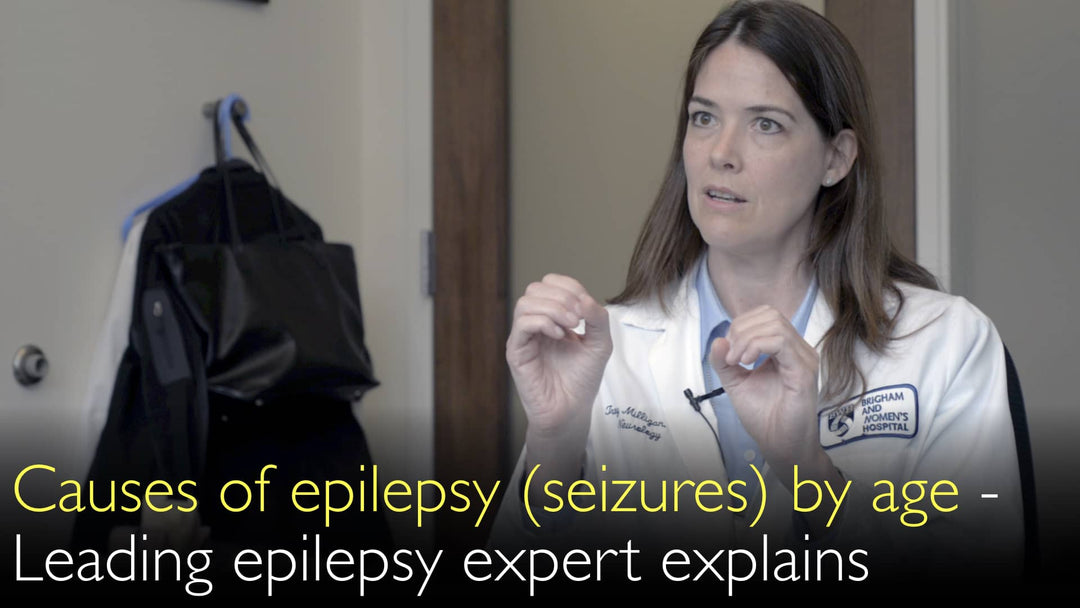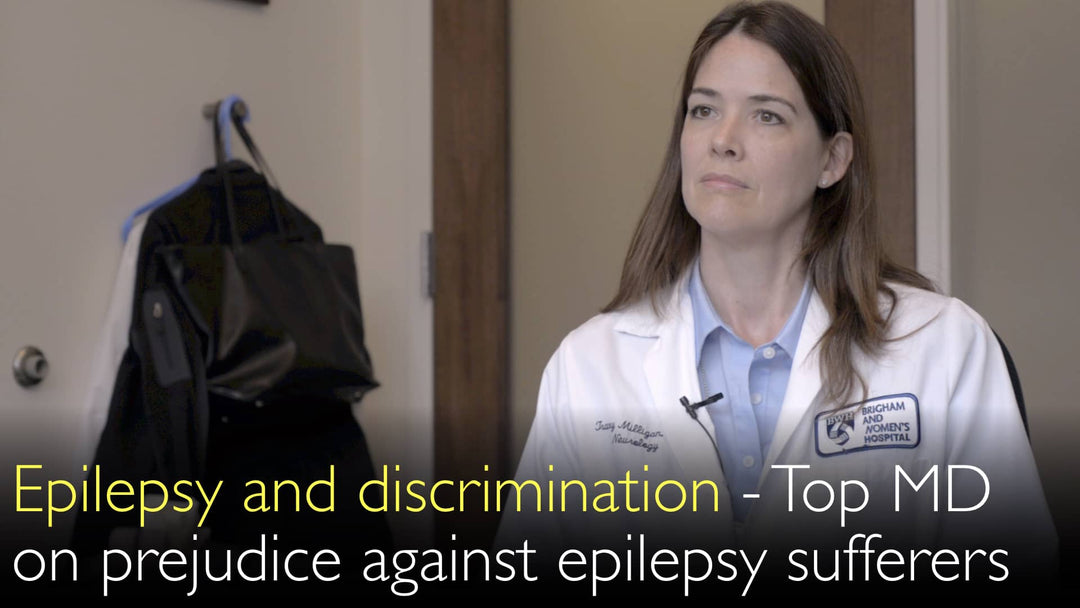Leading expert in epilepsy and seizure disorders, Dr. Tracey Milligan, MD, explains the major causes of new-onset epileptic seizures across different age groups. She details the two most common periods for epilepsy onset: infancy and after age 60. Causes range from birth trauma and genetic conditions in the young to stroke and neurodegenerative diseases in the elderly. Dr. Milligan also discusses common triggers for seizures in genetically susceptible young adults, such as sleep deprivation and alcohol use.
Understanding the Causes of Epilepsy and Seizures by Age Group
Jump To Section
- Epilepsy Overview and Prevalence
- Causes of Epilepsy in Infants and Young Children
- Causes of Epilepsy in the Elderly
- Causes of Epilepsy in Teenagers and Adults
- Genetic Epilepsy and Common Seizure Triggers
- Full Transcript
Epilepsy Overview and Prevalence
Epilepsy is a relatively common neurological disorder characterized by recurrent, unprovoked seizures. Dr. Tracey Milligan, MD, notes that it is the fourth most common neurologic disorder. She states that approximately one in twenty-six people will develop epilepsy during their lifetime.
The reasons why a person develops epilepsy and experiences their first epileptic seizure vary significantly depending on their age group. Dr. Anton Titov, MD, and Dr. Tracey Milligan, MD, discuss how the underlying causes are distinctly different for a newborn, a young adult, and an elderly individual.
Causes of Epilepsy in Infants and Young Children
The first year of life is one of the two most common periods for the onset of epileptic seizures. Dr. Tracey Milligan, MD, explains that causes in this age group are often related to events surrounding birth or congenital conditions.
Babies may suffer trauma during childbirth, leading to brain injury. Other common causes include genetic disorders, congenital structural brain diseases, and metabolic diseases. Infections that affect the brain can also be a trigger for the new onset of seizures in very young children.
Causes of Epilepsy in the Elderly
The incidence of new-onset epileptic seizures rises sharply with advancing age. Dr. Tracey Milligan, MD, emphasizes that the most common time for a person to develop epilepsy is actually after the age of 75, which surprises many patients.
In the elderly, epilepsy is mainly due to accumulated trauma or damage to the brain over time. The most frequent causes are stroke and other forms of vascular damage to the brain. A past traumatic brain injury can also manifest as epilepsy later in life. Furthermore, neurodegenerative disorders like Alzheimer's disease are a significant cause, as the aging brain becomes more susceptible to seizures.
Causes of Epilepsy in Teenagers and Adults
While individuals can develop epilepsy at any time, the causes during teenage years and adulthood differ. Dr. Tracey Milligan, MD, indicates that a genetic or congenital cause is often behind seizures that first appear in a patient's teens, 20s, or even early 30s.
A defective gene may have been present since birth but does not manifest with clinical seizures until this later stage of brain development. Other important causes of new-onset seizures in adults include traumatic brain injuries and brain tumors. Dr. Anton Titov, MD, highlights the importance of investigating the brain's structure to identify a potential cause whenever a patient presents with a first seizure.
Genetic Epilepsy and Common Seizure Triggers
Genetic causes of epilepsy are remarkably common and can explain many cases that appear in young adulthood. Dr. Tracey Milligan, MD, discusses how specific life events can trigger a first seizure in a genetically susceptible person.
Common triggers include significant sleep deprivation, alcohol use, and high levels of stress. She uses the example of a college student, whose new lifestyle away from home combines all these factors, potentially triggering a first seizure. This is often seen in specific syndromes like juvenile myoclonic epilepsy, where the genetic predisposition exists for years but only becomes clinically apparent when these external triggers are introduced.
Full Transcript
Dr. Anton Titov, MD: Epilepsy is a relatively common medical problem. Epilepsy is also called epileptic seizure disorder. What are major causes of new onset of epileptic seizures? Are causes of new-onset epileptic seizures different in different age groups?
Dr. Tracey Milligan, MD: Epilepsy is one of the most common neurologic disorders. It is the fourth most common neurologic disorder. One in twenty-six patients will develop epilepsy in their lifetime.
Why they develop epilepsy? Why they have their first epileptic seizure? It really does vary depending on the age group.
There are two most common time periods for patients to develop epilepsy. One time period is during the first year of life of a person.
Those are babies who suffer some trauma in childbirth. There are also small children who have a genetic or congenital cause for epilepsy. Cause of epileptic seizures may be a metabolic disease or structural brain disease. Injury to the brain or an infection can cause epilepsy. Other injury that happened during birth can also cause epilepsy.
The second most common time period when patients develop epilepsy is after the age of 60. The incidence of epileptic seizures rises with advancing age. The most common time for patients to develop epilepsy during their lifetime is after the age of 75.
Many patients don't realize that. It is more common to develop epilepsy as people are getting older than at any other time in life.
These are reasons why patients develop epilepsy when they are elderly. It is mainly due to some trauma that has happened to the brain over time. That could be a traumatic brain injury or a stroke. Trauma could be a vascular damage to the brain. Trauma could be a result of something that happened earlier in life.
As the brain ages, it becomes more susceptible to having an epileptic seizure. Sometimes patients develop epilepsy as a result of a neurodegenerative disorder like Alzheimer disease.
Those are two most common time periods for patients to develop epileptic seizures. But patients can develop epileptic seizures all through their life. People can develop epileptic seizures at any time of life.
In teenage and young adult years, the most common cause of epilepsy is a genetic or congenital cause. The brain is constantly changing throughout our lifetime. It could be that defective gene was present even before birth. But that gene may not manifest itself with the epileptic seizure until the teen years or 20s. Seizures may appear even sometimes in early 30s.
A trauma in the brain is another reason why patients develop epilepsy in their teens, 20s, 30s, 40s, 50s. Brain tumors are also a cause of new onset of epileptic seizures during adulthood.
Dr. Anton Titov, MD: When patients do develop epileptic seizures, we want to look at the structure of the brain.
Dr. Tracey Milligan, MD: We want to see if we can identify a cause. But sometimes epilepsy is explained by the genetics of the patient. It seems that genetic causes of epilepsy are so common. This is a common cause of epilepsy even when patients develop their first epileptic seizure in teenage years and in 20s and 30s.
Dr. Anton Titov, MD: What events usually trigger the manifestation of a genetic problem? What events happen to patients that can trigger an epileptic seizure in a genetically-susceptible person?
Dr. Tracey Milligan, MD: We are in Boston now. In Boston we have a lot of colleges and universities. A typical patient that we see in a Boston emergency room is a college student. This student is now in college and not sleeping as much. This student maybe is drinking alcohol.
Sleep deprivation, alcohol use, stress of being away from home and being in a university can trigger an epileptic seizure in somebody who genetically susceptible to epilepsy.
There is a syndrome called juvenile myoclonic epilepsy. Sometimes we see patients who have had that genetic disorder their entire lives. But then they come to college and have these additional stressors in their life. They also are older.
Dr. Anton Titov, MD: That is when patients with juvenile myoclonic epilepsy first have a clinical epileptic seizure.







